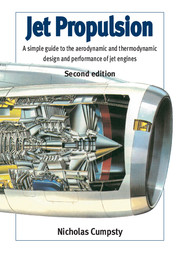 Jet Propulsion
Jet Propulsion Book contents
- Frontmatter
- Contents
- Preface
- Glossary
- Nomenclature
- Part 1 Design of Engines for a New 600-seat Aircraft
- Part 2 Engine Component Characteristics and Engine Matching
- Part 3 Design of Engines for a New Fighter Aircraft
- 13 A New Fighter Aircraft
- 14 Lift, Drag and the Effects of Manoeuvring
- 15 Engines for Combat Aircraft
- 16 Design Point for a Combat Engine
- 17 Combat Engines Off-design
- 18 Turbomachinery for Combat Engines
- Part 4 Return to the Civil Transport Engine
- Appendix: Noise and its Regulation
- Bibliography
- References
- Index
- Design sheets for New Large Civil Aircraft and New Fighter Aircraft
17 - Combat Engines Off-design
from Part 3 - Design of Engines for a New Fighter Aircraft
- Frontmatter
- Contents
- Preface
- Glossary
- Nomenclature
- Part 1 Design of Engines for a New 600-seat Aircraft
- Part 2 Engine Component Characteristics and Engine Matching
- Part 3 Design of Engines for a New Fighter Aircraft
- 13 A New Fighter Aircraft
- 14 Lift, Drag and the Effects of Manoeuvring
- 15 Engines for Combat Aircraft
- 16 Design Point for a Combat Engine
- 17 Combat Engines Off-design
- 18 Turbomachinery for Combat Engines
- Part 4 Return to the Civil Transport Engine
- Appendix: Noise and its Regulation
- Bibliography
- References
- Index
- Design sheets for New Large Civil Aircraft and New Fighter Aircraft
Summary
INTRODUCTION
The engine for a high-speed aircraft is required to operate over a wide range of conditions and some of these have been discussed in Chapters 13, 14 and 15. Of particular importance is the variation in inlet stagnation temperature, which can vary from around 216 K up to nearly 400 K for a Mach-2 aircraft. As a result the ratio of turbine inlet temperature to engine inlet temperature T 04/T 02 alters substantially, even when the engine is producing the maximum thrust it is capable of. In contrast, for the subsonic civil aircraft the value of T 04/T 02 changes comparatively little between take off, climb and cruise, the conditions critical in terms of thrust and fuel consumption, and it is normally only when a civil aircraft is descending to land or is forced to circle an airport that T 04/T 02 is reduced radically.
In Chapter 8 the dynamic scaling and dimensional analysis of engines was considered. There the engine non-dimensional operating point was held constant, for example T 04/T 02 is not constant, so the engine remained ‘on-design’. To designate the engine operating condition the value of N/√(c p T 0) or any of the pressure ratios or non-dimensional mass flows could also be used, but T 04/T 02 has the intuitive advantage since engine thrust is altered by varying fuel flow rate to change T 04. In Chapter 12 the more challenging issue of a civil engine operating away from its design condition was addressed, i.e. the case when T 04/T 02 ≠ constant, and the subject of this chapter is the similar case for military engines.
- Type
- Chapter
- Information
- Jet PropulsionA Simple Guide to the Aerodynamic and Thermodynamic Design and Performance of Jet Engines, pp. 242 - 261Publisher: Cambridge University PressPrint publication year: 2003


